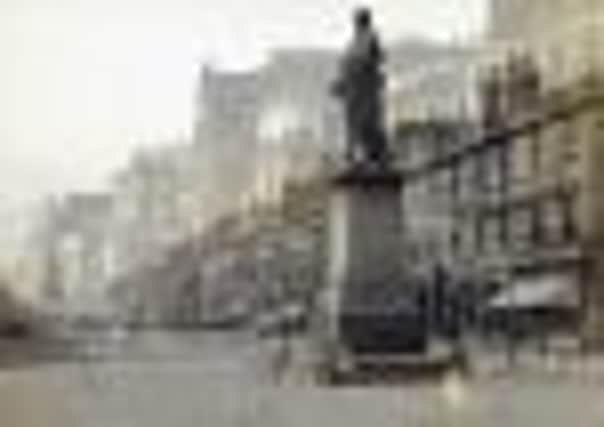Edinburgh through the ages shown in new archive


DRESSED in a black, ruffled peacoat capped off with boater hat, a quizzical-looking lady strides up the cobbled stones of North Bridge.
It’s 1901, and cranes and scaffold pierce the sky behind her as the ornamental stone lid is busily being fixed to a half-built North British Hotel.
Advertisement
Hide AdAdvertisement
Hide AdThe famous clock face that dominates the East End today is conspicuous by its absence, likewise the traffic islands and bus lanes that pepper the arterial route into the Old Town.
But with a swipe of a finger – or a cursor – you are catapulted into the 21st century. Now, the partially-constructed hotel is complete – and called the Balmoral – while its clock tower basks in summer sunlight and a maroon Lothian bus ambles towards Princes Street.
These snapshots, taken a century apart, form part of a new digital archive called Our Town Stories which charts the changing face of the Capital.
Its Now and Then section sees sharp colour photographs from today neatly layered over sepia images from a bygone era, offering a glimpse of the huge transformations or otherwise in Edinburgh architecture, allowing the user to flit between old and new pictures of the same city scene.
Based on the familiar Google Map style, the interactive resource opens the city up to armchair explorers interested in learning more about its notable characters, rich heritage and famous stories.
Content dates from 1700, and the site provides access to a slew of historical maps, links to a genealogy help page on the council’s website and allows users to contribute their own family tales.
Amateur historian David McLean, 27, who founded the hugely popular Lost Edinburgh Facebook page said the new library resource was “second to none”.
He said: “They have images going all the way back to the 1840s, and the information added to it is in depth and you can learn a lot from it.
Advertisement
Hide AdAdvertisement
Hide Ad“The content is also high resolution and fantastic visually, plus the Now and Then section is really simple to use.”
He added: “The interactive map makes it really easy to navigate around and sets it apart from many of the other sites I use.
“The way it’s been designed means it’s certainly going to appeal to a wide demographic.”
Many of archive’s stories are of some renown, such as the Greyfriars Bobby section which plots an illustrated trail charting his life, while others lay bare the harsh realities of poverty in Victorian Edinburgh.
The little-known story of Polish immigrant Levi Prinski, a homeless orphan who arrived in 1870s, paints a depressing picture of life in the city.
Levi would hang out at Waverley Station, which was a favourite gathering place for street children as they tried to earn a few coins from the travellers. He would later write: “Every night I was in lodgings, I had to rise and go out when the people began their meal, for it was more than I could bear to sit and see the people at meal, and I had got none all day.”
But fate ultimately dealt Levi a kind hand after he won a place at the Industrial Brigade School, which taught “destitute and homeless” boys a trade.
An 1870s portrait of the boy-made-good – with side-swept hair, bow tie and jacket – accompanies the story, bringing it to life. It also includes lithographs of Victorian working conditions.
Advertisement
Hide AdAdvertisement
Hide AdCentral themes in Edinburgh’s history, such as the role of women and history of firefighting, are chronicled by picture and word.
The city’s role in fire prevention was written into statue by the Scottish Act of 1426, instructing town officers to ensure ladders, saws and fixed hooked poles were made available for residents to escape their crumbling tenements or tear down burning timbers.
Period sketches of some of the city’s most ferocious blazes, including the Great Fire of 1824 which burned the High Street for five days, killing 13 people, enliven the stories.
Councillor Richard Lewis, the city’s culture and sport convener, said of the new online archive: “Edinburgh City Libraries has the largest collection of material about Edinburgh in the world, including some very rare and unique items.
“With Our Town Stories we’re able to share some of this material online using maps, images and narrative to provide both a fun and educational resource.”
The website has been developed by the city’s library and information services with technical expertise from Eskimo Designs Ltd, a design agency based in Edinburgh.
It is available at www.ourtownstories.co.uk
Latest resource to take a trip down Edinburgh memory lane
OUR Town Stories follows on from the online educational resource from WhoseTown? designed for use in Edinburgh schools.
It ties in with Capital Collections, the digital image archive for Edinburgh libraries, museums and galleries, launched in 2008.
Advertisement
Hide AdAdvertisement
Hide AdLike its predecessor, the new site acts as a gateway to local history resources available through Edinburgh’s libraries.
It comes in the wake of several successful amateur image-based websites chronicling the Capital’s architectural heritage.
Among the most popular – despite running into early copyright issues – is the Facebook page Lost Edinburgh, founded by David McLean, who created a space devoted to the “documentation, discussion and appreciation of the city’s changing architecture”.
The site is mostly reliant on user-generated material but also draws on the Scotsman archive, private collections and, in some instances, the council’s photographic library.
The veteran heritage website dedicated to the city’s rich past is edinphoto.org.uk. Run by the Edinburgh Photographic Society, the site was launched in 2001 and has received thousands of messages of support from around the world.